

38 Prompts Merging Reflective Thinking With Bloom's Taxonomy. 38 Prompts Merging Reflective Thinking With Bloom’s Taxonomy contributed by Peter Pappas My interest in reflective thinking is rooted in a simple but powerful statement by Donald Finkel who wrote that teaching should be thought of as “providing experience, provoking reflection” (Teaching with Your Mouth Shut).
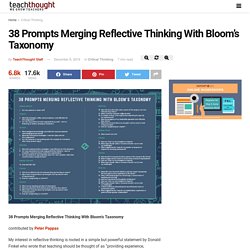
Most school mission statements include a reference to ‘fostering life-long learners.’ Nonetheless, if you walk through some schools you will see adults telling students what’s worth knowing and then evaluating the students on their success. I doubt that inspires students to take responsibility for their education. Unfortunately, self-reflection is rarely taught in school. I developed my Taxonomy of Reflection in an effort to provide a schema of prompts that could be used by students, teachers, and administrators to hone their reflective skills. Below are 38 examples of higher-order reflective prompts. As always, comments are welcome! 1. Student 2. 3. Teacher 4. 5. 6. Principal 7. 8. 9. Reflection Guidelines – The Global Citizen Diploma. How To Write IB Extended Essay Reflections. How To Write IB Extended Essay Reflections As you already know, the new extended essay criteria include 6 marks for “Engagement.”
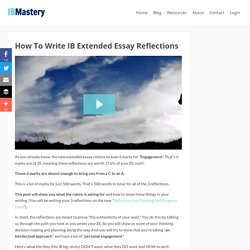
That's 6 marks out of 35, meaning these reflections are worth 17.6% of your EE mark! Those 6 marks are almost enough to bring you from a C to an A. This is a lot of marks for just 500 words. The Reflective Student: A Taxonomy of Reflection (Part 2) – Copy / Paste by Peter Pappas. Reflective student Reflection can be a challenging endeavor.
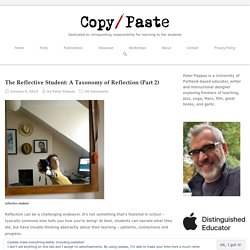
It’s not something that’s fostered in school – typically someone else tells you how you’re doing! At best, students can narrate what they did, but have trouble thinking abstractly about their learning – patterns, connections and progress. In an effort to help schools become more reflective learning environments, I’ve developed this “Taxonomy of Reflection” – modeled on Bloom’s approach. It’s posted in four installments: 1. See my Prezi tour of the Taxonomy 2. DP EE Guide- Reflection. There are three mandatory reflection sessions that are a formal part of the extended essay and should be recorded on the Reflections on planning and progress form.

Following each session, students are required to complete the relevant comment section on the form and submit it to their supervisor. The supervisor must then sign and date the form and after the final reflection session, the viva voce, add their own comment. For more information on the protocols for completing and submitting the Reflections on planning and progress form please refer to the section “Protocols on completing and submitting the Reflections on planning and progress form”. Following the completion of all three sessions, the form will be submitted to the International Baccalaureate along with the completed extended essay. The Best Self-Assessment Questions for Encouraging a Growth Mindset. The Art of Reflection.
A few weeks ago, I met with a group of educators to discuss their observations from a series of learning walks in classrooms.
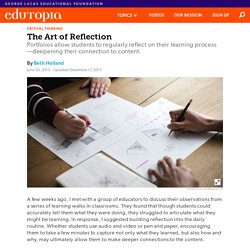
They found that though students could accurately tell them what they were doing, they struggled to articulate what they might be learning. In response, I suggested building reflection into the daily routine. Whether students use audio and video or pen and paper, encouraging them to take a few minutes to capture not only what they learned, but also how and why, may ultimately allow them to make deeper connections to the content. This naturally led to a conversation about portfolios. Portfolio discussions typically center on the tools: how to save, share, and publish student work. Framing and Reflection during the design process. Jackie Gerstein is an experienced educator who has been working as a classroom teacher and pre-service teacher trainer for years.

With a background in experiential learning, Gerstein is excited about current trends in education that have more people excited to try project-based learning, maker education and other approaches that let students get hands-on with their learning. She hopes all the excitement turns into robust, meaningful change in how mainstream teachers educate. To do that, she says it’s crucial that teachers not only focus on the materials and tools of a maker activity, but also carefully frame it and reflect upon it to make sure learning happens.
Amplify Reflection. Reflection is an important component of the learning process.
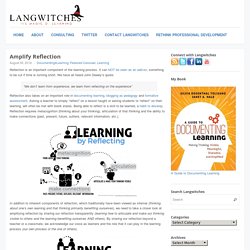
It can NOT be seen as an add-on, something to be cut if time is running short. We have all heard John Dewey’s quote: “We don’t learn from experience, we learn from reflecting on the experience” 40 Reflection Questions. MYP Projects guide- Process Journal. For both the community project and the personal project, students are expected to document their process in the process journal.
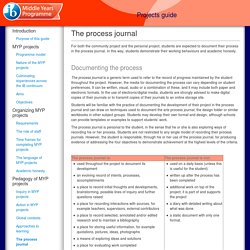
In this way, students demonstrate their working behaviours and academic honesty. Documenting the process The process journal is a generic term used to refer to the record of progress maintained by the student throughout the project. However, the media for documenting the process can vary depending on student preferences. It can be written, visual, audio or a combination of these, and it may include both paper and electronic formats. Students will be familiar with the practice of documenting the development of their project in the process journal and can draw on techniques used to document the arts process journal, the design folder or similar workbooks in other subject groups.